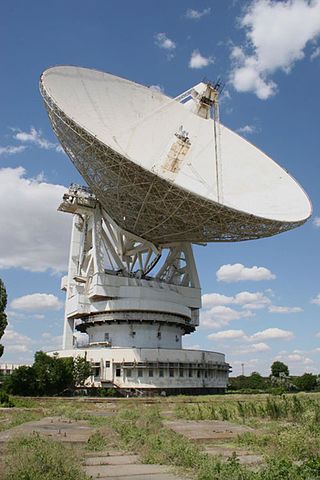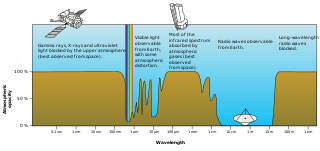The decibel is a relative unit of measurement equal to one tenth of a bel (B). It expresses the ratio of two values of a power or root-power quantity on a logarithmic scale. Two signals whose levels differ by one decibel have a power ratio of 101/10 or root-power ratio of 101/20.
The search for extraterrestrial intelligence (SETI) is a collective term for scientific searches for intelligent extraterrestrial life. Methods include monitoring electromagnetic radiation for signs of transmissions from civilizations on other planets, optical observation, and the search for physical artifacts. Attempts to message extraterrestrial intelligences have also been made.

Shot noise or Poisson noise is a type of noise which can be modeled by a Poisson process.

Signal-to-noise ratio is a measure used in science and engineering that compares the level of a desired signal to the level of background noise. SNR is defined as the ratio of signal power to noise power, often expressed in decibels. A ratio higher than 1:1 indicates more signal than noise.

The Kardashev scale is a method of measuring a civilization's level of technological advancement based on the amount of energy it is capable of harnessing and using. The measure was proposed by Soviet astronomer Nikolai Kardashev in 1964, and was named after him.
In sound processing, the mel-frequency cepstrum (MFC) is a representation of the short-term power spectrum of a sound, based on a linear cosine transform of a log power spectrum on a nonlinear mel scale of frequency.

The Wow! signal was a strong narrowband radio signal detected on August 15, 1977, by Ohio State University's Big Ear radio telescope in the United States, then used to support the search for extraterrestrial intelligence. The signal appeared to come from the direction of the constellation Sagittarius and bore expected hallmarks of extraterrestrial origin.
In audio engineering, electronics, physics, and many other fields, the color of noise or noise spectrum refers to the power spectrum of a noise signal. Different colors of noise have significantly different properties. For example, as audio signals they will sound different to human ears, and as images they will have a visibly different texture. Therefore, each application typically requires noise of a specific color. This sense of 'color' for noise signals is similar to the concept of timbre in music.

The Teen Age Message (TAM) was a series of interstellar radio transmissions sent from the Yevpatoria Planetary Radar to six solar-type stars during August–September 2001. The structure of the TAM was suggested by Alexander Zaitsev, Chief Scientist at Russia's Institute of Radio-engineering and Electronics. The message's content and target stars were selected by a group of teens from four Russian cities, who collaborated in person and via the Internet. Each transmission comprised three sections: a sounding, a live theremin concert, and digital data including images and text. TAM was humanity's fourth Active SETI broadcast and the first musical interstellar radio message.

The Allen Telescope Array (ATA), formerly known as the One Hectare Telescope (1hT), is a radio telescope array dedicated to astronomical observations and a simultaneous search for extraterrestrial intelligence (SETI). The array is situated at the Hat Creek Radio Observatory in Shasta County, 290 miles (470 km) northeast of San Francisco, California.
In telecommunications, the carrier-to-noise ratio, often written CNR or C/N, is the signal-to-noise ratio (SNR) of a modulated signal. The term is used to distinguish the CNR of the radio frequency passband signal from the SNR of an analog base band message signal after demodulation. For example, with FM radio, the strength of the 100 MHz carrier with modulations would be considered for CNR, whereas the audio frequency analogue message signal would be for SNR; in each case, compared to the apparent noise. If this distinction is not necessary, the term SNR is often used instead of CNR, with the same definition.

The waterhole, or water hole, is an especially quiet band of the electromagnetic spectrum between 1420 and 1662 megahertz, corresponding to wavelengths of 18–21 centimeters. It is a popular observing frequency used by radio telescopes in radio astronomy.

Underwater acoustics is the study of the propagation of sound in water and the interaction of the mechanical waves that constitute sound with the water, its contents and its boundaries. The water may be in the ocean, a lake, a river or a tank. Typical frequencies associated with underwater acoustics are between 10 Hz and 1 MHz. The propagation of sound in the ocean at frequencies lower than 10 Hz is usually not possible without penetrating deep into the seabed, whereas frequencies above 1 MHz are rarely used because they are absorbed very quickly.

A-weighting is a form of frequency weighting and the most commonly used of a family of curves defined in the International standard IEC 61672:2003 and various national standards relating to the measurement of sound pressure level. A-weighting is applied to instrument-measured sound levels in an effort to account for the relative loudness perceived by the human ear, as the ear is less sensitive to low audio frequencies. It is employed by arithmetically adding a table of values, listed by octave or third-octave bands, to the measured sound pressure levels in dB. The resulting octave band measurements are usually added to provide a single A-weighted value describing the sound; the units are written as dB(A). Other weighting sets of values – B, C, D and now Z – are discussed below.

H. Paul Shuch is an American scientist and engineer who has coordinated radio amateurs to help in the search for extraterrestrial intelligence (SETI).
Active SETI is the attempt to send messages to intelligent extraterrestrial life. Active SETI messages are predominantly sent in the form of radio signals. Physical messages like that of the Pioneer plaque may also be considered an active SETI message. Active SETI is also known as METI.
A post-detection policy (PDP), also known as a post-detection protocol, is a set of structured rules, standards, guidelines, or actions that governmental or other organizational entities plan to follow for the "detection, analysis, verification, announcement, and response to" confirmed signals from extraterrestrial civilizations. Though no PDPs have been formally and openly adopted by any governmental entity, there is significant work being done by scientists and nongovernmental organizations to develop cohesive plans of action to utilize in the event of detection. The most popular and well known of these is the "Declaration of Principles Concerning Activities Following the Detection of Extraterrestrial Intelligence", which was developed by the International Academy of Astronautics (IAA), with the support of the International Institute of Space Law. The theories of PDPs constitute a distinct area of research but draw heavily from the fields of SETI, METI, and CETI.
The cultural impact of extraterrestrial contact is the corpus of changes to terrestrial science, technology, religion, politics, and ecosystems resulting from contact with an extraterrestrial civilization. This concept is closely related to the search for extraterrestrial intelligence (SETI), which attempts to locate intelligent life as opposed to analyzing the implications of contact with that life.

Iván Almár is a Hungarian astronomer. He proposed the San Marino Scale as a means of assessing risks related to extraterrestrial communication. Almár also serves on the Advisory Council of METI. Asteroid 191856 Almáriván, discovered by Hungarian astronomer Krisztián Sárneczky at the Piszkéstető Station in 2004, was named in his honor. The official naming citation was published by the Minor Planet Center on 10 December 2011.
The Rio scale was proposed in 2000 as a means of quantifying the significance of a SETI detection. The scale was designed by Iván Almár and Jill Tarter to help tell policy-makers how likely, from 0 to 10, it is that an extraterrestrial radio signal has been produced by an intelligent civilization.












